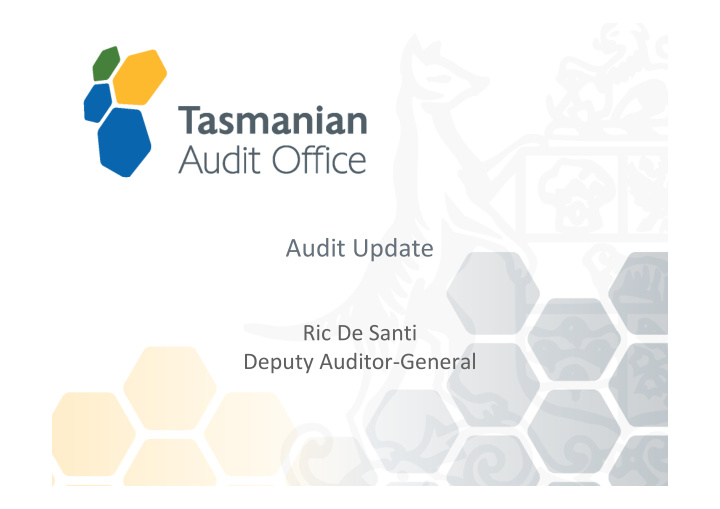



Audit Update Ric De Santi Deputy Auditor-General
Outline • Audit findings and key and significant risk areas • Audit focus and changes 2019 • Are subsidiaries State entities? • Do you have internal controls in place to protect against fraudulent email/communication attempts? • Some resources 115
116
Financial statement audits 2018 117
Outcomes of audits 118
Audit findings 119
120
PPE valuation – Common challenges 1. Determining the valuation approach with consideration for highest and best use 2. Identifying the significant parts of an infrastructure asset 3. Deciding whether to use greenfield or brownfield costs 4. Reviewing useful lives and residual values 5. Utilising condition ratings appropriately 6. Reviewing and documenting valuation assumptions and inputs 121
Other matters Asset recognition/de-recognition or valuation Prior period error Found assets Asset recognised at fair value in Land transfers income statement Derecognised Scrapped or demolished assets Reduced useful life or Damaged assets derecognised Reclassify, market valuation Assets held for sale Replaced by obsolescence Impairment (NFP) 122
Audit focus 2018-19 • Inclusion of key audit matters in opinions for all councils • Greater focus on IT controls • Bringing work forward, especially asset revaluations • Focus on: – Asset WIP capitalisation policy – overhead allocations – Valuations – Asset lives – determination and consistency – Prior period errors • Report to Parliament - – Capital expenditure – explanations for not achieving capital expenditure plans 123
Further future changes • New audit methodology and technology platform. • Proposed Auditing Standard ASA 315 Identifying and Assessing the Risks of Material Misstatement 124
Are subsidiaries State entities? • If an entity is a State entity in its own right, it will not be a subsidiary of a State entity, regardless of the relationship it has with another State entity. • Subsidiary incorporated under Corporations Act that is controlled by a State authority falls into the meaning of a State owned company = State entity • Body or authority established under section 21 (corporation, trust, partnership or other body), section 29 (controlling authorities) or 30 (single or joint authorities) of LGA 1993 = State entity So what does this all mean? 125
Are subsidiaries State entities? State entity Subsidiary of a State entity (includes subsidiaries set up under (Auditor-General the auditor of a subsidiary of a State entity unless he Corporations Act or local determines otherwise) government trust, partnership or other body controlled, single and Audited subsidiary of a State Non-audited subsidiary of a joint authorities) entity State entity (all subsidiaries of State (a subsidiary of a State entity entities where the Auditor- where the Auditor-General is General makes a the auditor) determination he is not auditor) Accountable Authority (State entities and audited subsidiaries of State entities must have) No financial statement reporting, submission or audit Accountable authorities - submit financial statements requirements (to Auditor General within 45 days after the end of each financial year) Financial Audit of State Audit of audited subsidiaries Audit of State entity dispensed of a State entity - no entity not statement with dispensation available dispensed with preparation, submission and Auditor-General to audit the financial audit obligations statements ( within 45 days of submission) 126
Do you have internal controls in place to protect against fraudulent email/communication attempts? Public sector entities have recently received emails or other communications where fraud was attempted by requesting changes to the bank account details of employees or suppliers. 127
Do you have internal controls in place to protect your organisation against fraudulent email/communication attempts? Here’s what you can do to help prevent frauds • Conduct a risk assessment and verify legitimacy of any changes in employee or supplier bank account details recently processed. • Take the following steps for change requests: – treat with suspicion – have effective verification controls (in place and tested) – authenticate directly with the employee or supplier – segregate access privileges – introduce controls immediately. 128
Useful resources 129 www.audit.tas.gov.au/resources/
Useful resources www.audit.tas.gov.au/resources/ 130
Useful resources https://www.audit.tas.gov.au/publ ication/local-government- authorities-2017-18/ 131
Recommend
More recommend